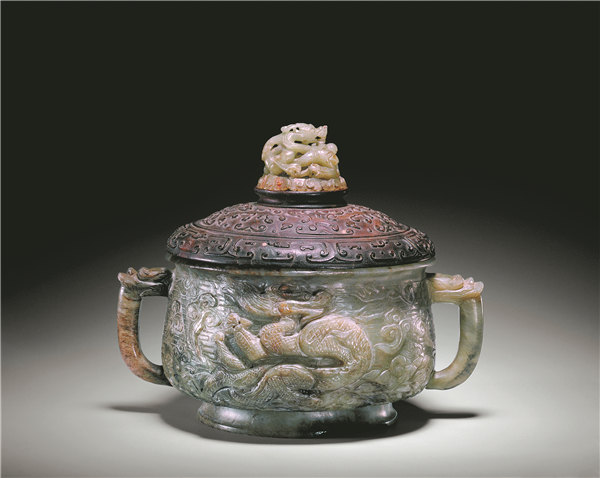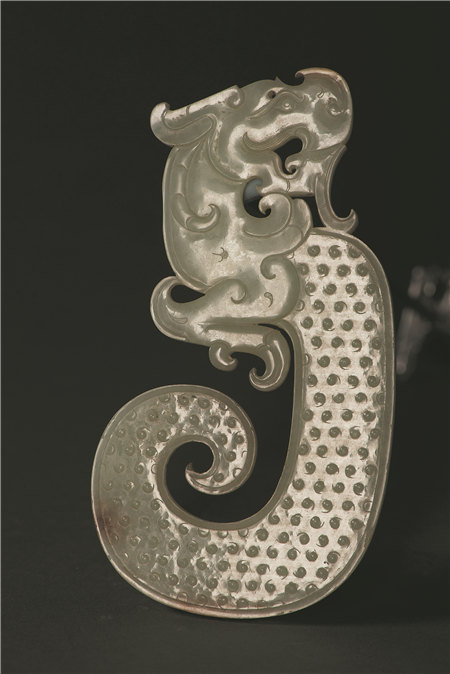Jade, deeply rooted in culture, continues to fascinate as it embodies myth and reality, Zhao Xu reports.
Almost without exception, everyone has rock-hunted in their youth — searching for that shiny, beautiful, rounded stone, feeling its cool surface, wrapping their fingers around it, and tucking it into a pocket where it bounces with every step. These are the shared memories lingering at the edges of recollection.
For Chinese people, there's one particular type of stone that holds a tender place in their collective memory: jade.
Jade is to the Chinese whatever a treasure stone is to a child, and much, much more.
Since its discovery millennia ago — with the earliest traces of jade use in China dating back nearly 9,000 years — it has been revered as a mineral of profound beauty. Yet beauty alone does not explain jade's esteemed status in classical Chinese culture.
"Jade emanates a soft luster comparable to the subtle sense of benevolence exuded by a noble soul," Confucius once remarked to a disciple.
The philosopher, regarded by future generations as the sage of all ages, lived between 551 and 479 BC. By then, jade had long been fully embraced by the Chinese, serving as decorations, funerary objects, and ritual wares believed to connect them with the forces of nature and their ancestors.
Prominent examples can be found from the abundance of jade wares associated with the Liangzhu Culture. Centered in the Yangtze River Delta region in eastern China, Liangzhu, which existed about 5,300 to 4,300 years ago, is today widely known as one of the country's key neolithic jade cultures. One signature form of Liangzhu jade, known as cong, comprises a cylindrical tube encased in a square prism.
"Cong, in my view, embodies within its geometric form the Liangzhu people's view of the universe," says Fang Xiangming, who heads the Zhejiang Provincial Institute of Cultural Relics and Archaeology, the organization behind the excavation of Liangzhu in recent decades.
"From top to bottom, the cylinder — if it can be called one — has a very slight taper. If you have the experience of standing in an open field surveying your surroundings with an unobstructed view, you would know that the earth is a circle — or at least appears so to you — with its border defined by where it meets the heaven. The heaven, of course, is also a circle, albeit a bigger one encompassing you."
In other words, the jade cong, like all other forms of Chinese ritual jades, embodies the cosmological perspective of the Chinese people.

A jade cong of Liangzhu Culture dating from about 5,300 to 4,300 years ago. [Photo provided to China Daily]
Another noteworthy aspect is that all Liangzhu cong pieces feature a distinctive pattern: a figure wearing a feathered crown rising above a wide-eyed, open-mouthed beast.
According to Fang, the prevalence of this pattern attests to a unified belief system upon which the civilization was built.
The same pattern also adorns a jade axe and a scepter unearthed from a royal cemetery on the site. Representations of military and religious power, they speak for the connection between jade and regal authority. The connection was fully explored in the ensuing millennia by successive Chinese emperors who reigned under the teachings of Confucius who believed in "rule by virtue".
During the Eastern Zhou Dynasty (770-256 BC), when Confucius lived, and the following Western Han Dynasty (206 BC-AD 24), the creation of funerary jade reached an artistic pinnacle. Kings of various vassal states were routinely interred from head to toe with exquisitely carved jade wares, which were expected to keep their bodies intact while their soul took the heavenward journey.
From the burial ground of a Han Dynasty vassal king in today's Xuzhou city, Jiangsu province, archaeologists unearthed what is believed to be some of the most majestic jade dragons yielded by any ancient Chinese tomb.
Horned and bearded, with flowing manes on the back and upwardly curled tufts of hair sprouting from the ankles, these S-shaped dragons are an amalgam of fantastical details, all contained within graceful curves, which in turn were realized with powerful simplicity. Their task was to carry the soul of the deceased to heaven.
In 139 BC, the powerful Western Han Emperor Wudi, who made Confucianism the official ideology for his and the following Chinese dynasties, sent envoys on a westward journey that was to give rise to the ancient Silk Road.
In conversation with Emperor Wudi upon his return 13 years later, Zhang Qian, head of the team, described a place where exquisite jade stones could be found along rivers or deep within mountains.

A hat finial featuring carved jade from the Yuan Dynasty (1271-1368). [Photo provided to China Daily]
Hotan jade, named after its place of origin in today's Xinjiang Uygur autonomous region, soon became China's most treasured jade material, sought after by all who had inhabited the land.
In 1271, the Mongols founded China's Yuan Dynasty (1271-1368), and it didn't take long for the Mongol elite of Yuan to incorporate jade into their dress code, wearing hats topped with round jade carvings.
Measuring no more than 5 centimeters in height, these carvings were conveniently dubbed "jade hat finials".
"These jade hat finials provide powerful examples of how a constantly evolving jade culture was adopted by a people eager to prove themselves legitimate rulers of China. They were statement jewelry in the true sense of the words," says Zuo Jun, an expert in ancient Chinese jade from the prestigious Nanjing Museum in eastern China.
According to him, precious stones such as sapphires were sometimes used in place of jade as hat finials, but were never held in the same high esteem.
The jade hat finials lost their prominence following the fall of the Yuan Dynasty in 1368, but they were not entirely forgotten. During the succeeding Ming Dynasty (1368-1644), they continued to be appreciated as elaborate works of art, reimagined as furnace tops that rested atop wooden lids covering jade furnaces. Inside these furnaces, incense — likely imported via the Silk Road — once smoldered, sending plumes of fragrant smoke through the holes of the openwork furnace top.

A Song Dynasty (960-1279) jade furnace from the collection of the Palace Museum features a wooden cover and a jade top, which are believed to be latter-day additions. [Photo provided to China Daily]
Most of these jade furnaces, similar to those created as far back as the Song Dynasty (960-1279), were based on the designs of bronze wares cast during China's Shang and Zhou dynasties, which spanned from the 16th to the 3rd centuries BC. In this context, Emperor Huizong of the Northern Song Dynasty, who lived between 1082 and 1135, played a significant role. Under his patronage, a small group of prominent antiquarian artists meticulously combed through and cataloged the emperor's enviable art collection, which included more than 800 pieces of bronze ware.
Depicted through both words and illustrations in a compilation titled An Inventory of Antiques From the Xuanhe Era, these bronze wares soon became templates for jade artisans. One bronze wine container in particular could have inspired a Song Dynasty jade furnace currently held by Beijing's Palace Museum.
Zuo, who included the item in an exhibition held early this year at the Nanjing Museum to trace the entire trajectory of China's jade development, believes that the ware's matching wooden cover and jade top were latter-day additions, probably from a Qing Dynasty (1644-1911) emperor.
"A deep sense of cultural awareness had grown from the accumulation of memories — this is what lies behind the furnace, which forms part of the Chinese jade story," Zuo remarks.

A funerary jade dragon from the Han Dynasty (206 BC-AD 220). [Photo provided to China Daily]